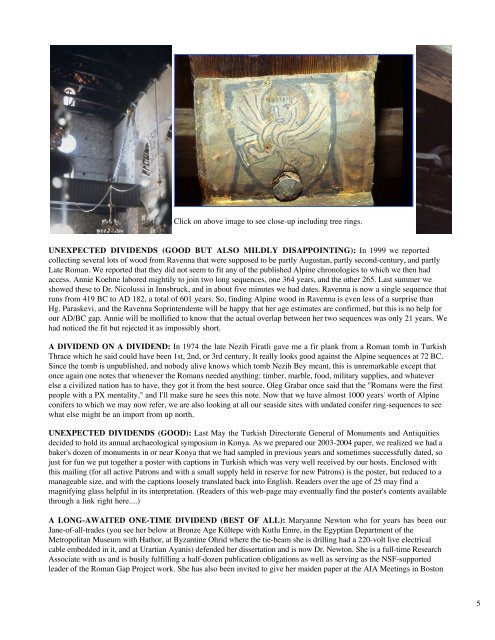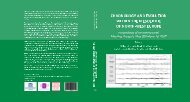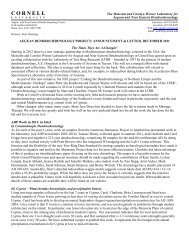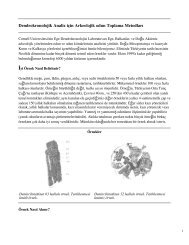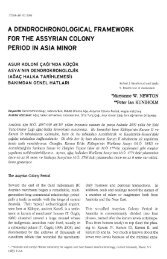Aegean Dendrochronology Project December 2004 Progress Report
Aegean Dendrochronology Project December 2004 Progress Report
Aegean Dendrochronology Project December 2004 Progress Report
Create successful ePaper yourself
Turn your PDF publications into a flip-book with our unique Google optimized e-Paper software.
Click on above image to see close-up including tree rings.<br />
UNEXPECTED DIVIDENDS (GOOD BUT ALSO MILDLY DISAPPOINTING): In 1999 we reported<br />
collecting several lots of wood from Ravenna that were supposed to be partly Augustan, partly second-century, and partly<br />
Late Roman. We reported that they did not seem to fit any of the published Alpine chronologies to which we then had<br />
access. Annie Koehne labored mightily to join two long sequences, one 364 years, and the other 265. Last summer we<br />
showed these to Dr. Nicolussi in Innsbruck, and in about five minutes we had dates. Ravenna is now a single sequence that<br />
runs from 419 BC to AD 182, a total of 601 years. So, finding Alpine wood in Ravenna is even less of a surprise than<br />
Hg. Paraskevi, and the Ravenna Soprintendente will be happy that her age estimates are confirmed, but this is no help for<br />
our AD/BC gap. Annie will be mollified to know that the actual overlap between her two sequences was only 21 years. We<br />
had noticed the fit but rejected it as impossibly short.<br />
A DIVIDEND ON A DIVIDEND: In 1974 the late Nezih Firatli gave me a fir plank from a Roman tomb in Turkish<br />
Thrace which he said could have been 1st, 2nd, or 3rd century. It really looks good against the Alpine sequences at 72 BC.<br />
Since the tomb is unpublished, and nobody alive knows which tomb Nezih Bey meant, this is unremarkable except that<br />
once again one notes that whenever the Romans needed anything: timber, marble, food, military supplies, and whatever<br />
else a civilized nation has to have, they got it from the best source. Oleg Grabar once said that the "Romans were the first<br />
people with a PX mentality," and I'll make sure he sees this note. Now that we have almost 1000 years' worth of Alpine<br />
conifers to which we may now refer, we are also looking at all our seaside sites with undated conifer ring-sequences to see<br />
what else might be an import from up north.<br />
UNEXPECTED DIVIDENDS (GOOD): Last May the Turkish Directorate General of Monuments and Antiquities<br />
decided to hold its annual archaeological symposium in Konya. As we prepared our 2003-<strong>2004</strong> paper, we realized we had a<br />
baker's dozen of monuments in or near Konya that we had sampled in previous years and sometimes successfully dated, so<br />
just for fun we put together a poster with captions in Turkish which was very well received by our hosts. Enclosed with<br />
this mailing (for all active Patrons and with a small supply held in reserve for new Patrons) is the poster, but reduced to a<br />
manageable size, and with the captions loosely translated back into English. Readers over the age of 25 may find a<br />
magnifying glass helpful in its interpretation. (Readers of this web-page may eventually find the poster's contents available<br />
through a link right here....)<br />
A LONG-AWAITED ONE-TIME DIVIDEND (BEST OF ALL): Maryanne Newton who for years has been our<br />
Jane-of-all-trades (you see her below at Bronze Age Kültepe with Kutlu Emre, in the Egyptian Department of the<br />
Metropolitan Museum with Hathor, at Byzantine Ohrid where the tie-beam she is drilling had a 220-volt live electrical<br />
cable embedded in it, and at Urartian Ayanis) defended her dissertation and is now Dr. Newton. She is a full-time Research<br />
Associate with us and is busily fulfilling a half-dozen publication obligations as well as serving as the NSF-supported<br />
leader of the Roman Gap <strong>Project</strong> work. She has also been invited to give her maiden paper at the AIA Meetings in Boston<br />
5


